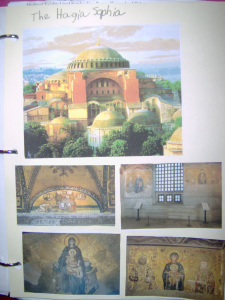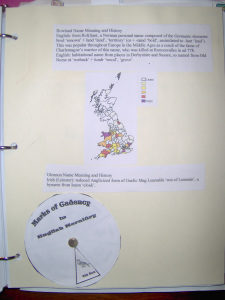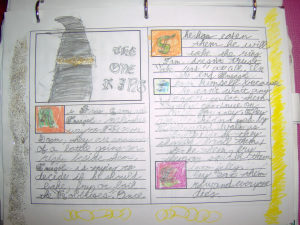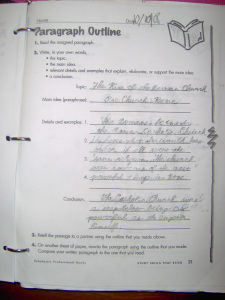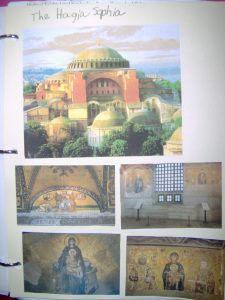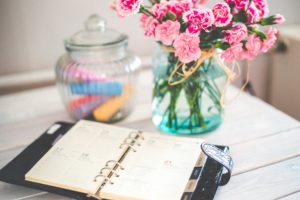Combining Notebooking and Lapbooks
Combining notebooking and lapbooks is not difficult and can be a lot of fun and effective. Have you been curious about using lapbooks or notebooking pages? Trying to decide which one is right for your family? Do you like the idea of those fun looking lapbooks but not sure about all of the cutting and pasting?
I tried lapbooking with my two non-cutting, non-coloring boys (who don’t mind making things from scratch or writing notebooking pages and adding their own artistic renderings of what they have written). It was not the success I had envisioned or hoped for.
Something about the file folder and putting all of these little booklets on the file folder turned them off. I still don’t completely understand the emotional reaction they had to this, but we have found something that does work for us.
I’d like to share this idea with you. It was a compromise that seemed to work for us and we enjoyed the process and loved the end result!
We use pieces of card stock, 3-hole punched and place these into our notebooks alongside our notebook pages. We do a couple of little booklets or whatever at a time and glue them onto the card stock as we study the topic throughout the semester.
I think the variety of combining the written narration, their own drawings, and the booklets a few at a time breaks up what they might have felt as either overwhelming or monotonous in putting together a big lapbook alone.
To give you some ideas of what we have done, I broke down ideas into subject areas and have included pictures, descriptions of what we have done, and links to resources you might find helpful:
- Science
Botany Notebook – Using Jeannie Fullbright’s Exploring Creation with BotanyWhenever we went on a nature walk, Charlotte Mason style, we would look for a sample of the plant life he was studying in this book to take home. We dried it, glued it onto a piece of card stock, labeled it, slipped it into a plastic sheet protector, and placed it into the notebook with the rest of the pages.
At the same time, I printed off little diagrams or booklets about parts of a flower, seed, or plant that he would label or fill out. After completing each one, he glued that onto a piece of card stock and placed it into the notebook in the appropriate section discussing that topic.
Each piece of card stock would be labeled with the topic on that page, and would be close to full- so that it wasn’t just one or two small items on the page.
Whenever, my son had a science experiment to perform, we had a science experiment procedure notebook page, that he would use to write out his hypothesis, materials, procedures, observations, data, results, and conclusion. This page would also go in the appropriate area of study.
In the end, he had a nice botany notebook with a cover provided in the free notebooking pages filled with samples, notes, experiments, and little diagrams and booklets. All of these placed in topic areas, as opposed to notebook sections labeled “notes”, “labs”, “projects”. This was more fluid for him.
- Apologia General Science with my older son was a bit different.My older son likes a bit more structure and functions better when things are categorized. He labeled sections of his notebook “notes” (written narrations for him or handouts of notes), “labs”, “questions and answers” (lapbook parts from Live and Learn Press), “quizzes” (review study guides and tests provided by Apologia), and a pocket for index cards that he used to make flash cards for himself from the study guide questions.
His notebook was organized according to function of the piece of paperwork. It was a combination of notebooking pages on which he wrote narrations of topics he read aside from the Apologia text and handouts where he read something and answered questions (this usually was a tie in to the historic period we were studying and how it related to his science), science experiment procedure notebooking pages (just like his brother) or printed from the Apologia text CD-Rom, and lapbook booklets glued onto pieces of card stock.
The lapbook components we use are from Live and Learn Press. They have booklets in which he can write the answers to questions from the Apologia text and write down definitions to vocabulary words as he proceeds through the text. My son glues these onto pieces of card stock as he works on them in order of the text.
Lapbooking pages sample with little booklets
- History
For the past two years, we have studied ancient civilizations and the middle ages. We put together a notebook for each during each year. We used a variety of notebooking pages from different sources for our written narrations and map study. For a study of crests and family history, we had matchbooks and other little books to glue onto cardstock to explain heraldry.For the chain of causes for the black plague, we used the wheel from the Story of the World Activity book, glued onto cardstock also.
This year, we will be studying the Renaissance; we’ll be using a lap book (glued onto card stock pages) for that as well from Live and Learn Press along with our notebooking pages.
Heraldry and our Ancestors
Lapbooking page sample with printed material found online
Notebooking page sample – making an illuminated page of copywork from Lord of the Rings
Notebooking page that practiced taking notes from a book in an outline form
Notebooking page about a feast during the Middle Ages
Learning about the Hagia Sophia
Lapbooking page sample with printed pictures about the Hagia Sophia
If you are interested in using notebooking pages to make an ABC book about the topics you have learned in a Middle Ages, Anciet Greece, or an Animal or Human Body unit study, you may be interested in these type of notebooking pages. We even have some for a Thanksgiving or Christmas unit study! You can see the variety of notebooking pages available here.
Notebooking Links
Here are a variety of resources that you may find helpful in assisting you in your notebooking endeavors:
Free Notebooking Pages(free sample pages to print and use) (affil. link)
http://highland.hitcho.com.au/notebooking.htm (ideas in how to use notebooking)
http://www.homeschoolhelperonline.com/notebooking.htm (free notebooking pages to print)
Lapbooking
http://www.homeschoolshare.com/lapbooking_resources.php (free lapbook templates and sets to print)
http://www.homeschoolhelperonline.com/lapbooks.htm (free lapbook sets to print)
I hope you find what works for your family, whether it’s notebooking or lapbooking, a combination of both, or something else!
Using Nature Studies to Teach Science is the Charlotte Mason way and you can read about it here.
To see a list of other posts related to Charlotte Mason Homeschooling click here.



